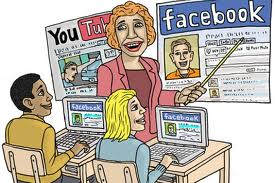Class Objectives met through this review:
1. Demonstrate the understanding of how technologies can effectively promote student learning
2. Evaluate and use a variety of current technologies to enhance content instruction and to advance students’ technological literacy
4. Reflect upon and demonstrate effective use of digital tools and resources
5. Demonstrate a comprehensive understanding of safe, ethical, legal and moral practices related to digital information and technology
8. Evaluate, adapt and reflect on emerging tools and trends by participating in local and global learning communities and by reviewing current research and professional literature
2. Evaluate and use a variety of current technologies to enhance content instruction and to advance students’ technological literacy
4. Reflect upon and demonstrate effective use of digital tools and resources
5. Demonstrate a comprehensive understanding of safe, ethical, legal and moral practices related to digital information and technology
8. Evaluate, adapt and reflect on emerging tools and trends by participating in local and global learning communities and by reviewing current research and professional literature
Many people feel that social media has no place in the classroom. Some see it as the new ‘bad boy’ on the block. But these views are beginning to change when we start to look at the potential social media has in education.
In the article entitled, Social Media: It Does Have a Place in the Classroom by James Careless, he discusses the question of social media in education and comes to the conclusion that social media does indeed have a place in today’s classroom.
Careless interviewed three educators, Dean Shareski, David Jakes and Carolyn Foote who all agree that social media cannot only improve the quality of education, but can make students more engaged in their learning. It can also allow for greater literacy because being literate in 2012 means being digitally literate.
Shareski says, “…you have to understand that social media is much more than just Facebook and Twitter. In reality, social media is any kind of media where there is the opportunity for people to interact online. That’s how all-encompassing it truly is.” I believe he is right. There are so many social media applications out there that can enhance student learning such as: blogs, interactive websites, chat-rooms, videos on YouTube and bookmarking sites. David Jakes also agrees by stating, “Anything that lets people interact online is effectively social.” Giving students the ability to post their creations online allows them to get accustomed to dealing with the outside world. Having students work online also pushes education beyond the confines of school, and it forces them to do "authentic" work that gets tested out in the real world, as other people see it and respond to it. Students also need to know that their work can have an impact on the outside world, and they should know that it is subject to positive or negative feedback. Being able to collaborate with other students, not only in their class but in classes around the world is an exceptional educational tool. Teachers have the ability to allow students to get their voices heard by using social networking. It is also important to note that by putting student’s work online allows the classroom to virtually be brought home. Parents can check in on their child’s work and progress by simply viewing what they have either posted on a creative writing blog for English class or view a video he or she made for a social studies research project. Something as simple as using Facebook to organize events could be extremely useful.
Careless mentions that it shouldn’t be a web free for all. Teachers and schools need to monitor web access. Teachers must help students figure out how to navigate the web so they "can get to the good stuff" that's applicable to school. Teachers also need to be responsible for educating the students to become good digital citizens and to be aware of their digital footprint. This type of technology can leave students open to stranger danger, expose them to unsavory sites or even serve as a distraction. But Foote notes that there have been distractions in schools even before computers. Jakes also mentions that strangers who comment on things rarely have ill intent in mind. That’s not to say there shouldn’t be an element of safety involved. Students should learn from their teachers some effective ways to deal with stranger danger through proper digital citizenship. Though there are risks associated with encouraging students to use social networking sites, I would argue that potential for opportunities outweigh the costs. As education and awareness about social media develop, social media resources may pave the way for growth in today’s schools.
Careless also comments on how teachers need to be educated on the ins and outs of the social media sites they plan to use in their classrooms. By doing this, they will enable their students to harness the potential that social media holds in being an effective educational tool.
Careless concludes his article by mentioning Frank Pileiro's 3 C's of social media success for teachers. The 3 C's are Connect, Collaborate and Curate. Connect to the right social media that works for you and that can be applied to your classroom. Collaborate and allows people so see your students work, and to be a contributor, not just a receiver of information. Curate to allow for organization of the sites you and your students are on. A good example of this is Diigo, which allows you to bookmark sites and leave notes or comments that can be shared.
Through utilizing teaching techniques that incorporate social media, teachers are able to increase students' engagement in learning, increase technological proficiency, contribute to a greater sense of collaboration in the classroom, and build better communication skills. The power of social media can be misleading, but now and into the future it can clearly be a tool for enhancing student learning.





No comments:
Post a Comment